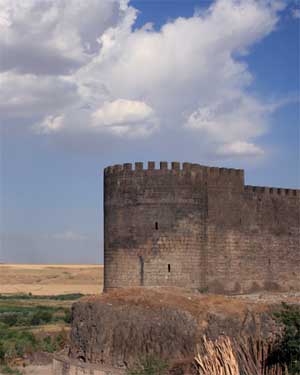Fancy a holiday to eastern Turkey? If you want the perfect base to visit two classic locations of Neolithic archaeology, Çayönü and Göbekli Tepe, you could do worse than stay in their ‘modern’ equivalent, the caravanserai of Diyarbakır.*
 I’ve just been to eastern Turkey with my partner, Steph. Without intending to we ended up in a city called Diyarbakır, down in the southeast of the country.
I’ve just been to eastern Turkey with my partner, Steph. Without intending to we ended up in a city called Diyarbakır, down in the southeast of the country.
Formerly known as ‘Diyar ı bekr’ until a mistake by Atatürk was approved by cabinet, Diyarbakır is an unusual town. It’s layout, pressed up against the green Tigris valley, means that the old, black-walled city centre lies at one edge, whilst the modern city of tower blocks sprawls for miles off to the northwest.
There’s a decided edge to the city at present. This is due to a number of interrelated factors. The city is dominated by ethnic Kurds, supposedly 90% of the population. Many of these came here in the last thirty years, trying to improve their lives and get away from fighting between government forces and Kurdish activists.
However, the people are overtly friendly*, the town is fascinating and the food is the best I’ve had in Turkey. Whilst this ancient city should be a tourist trap there are virtually no tourists, most scared away by largely unfair reports of trouble. Instead the city is underfunded and rather poor.
Prized caravanserai
Its current poverty was not always the case. Once Diyarbakır, and the land surrounding it, was the prize of many empires. To quote from ‘Diyarbakır: a cultural guide’:
‘Diyarbakır has known the rule of many tribes and states: the Hurris, Mitannis, Hittites, Persians, Assyrians, Aramids, Urartus, Scythians, Medes, Macedonians, Seleucids, Parthians, Romans, Sassanids, Byzantines, White Huns, Emevids, Abbasids, Mervanids, Oğuz, Seljuks, Artuluks, Eyyubids, Mongols, Turcomans, White Sheep Turks, Safevids and Ottomans.’
Now, even bearing in mind that the list may be slightly inaccurate (and was there really a tribe called the White Sheep Turks?), it’s still an impressive list. Compare to, say, where I live over the same period.
‘Swindon has known the rule of many tribes and states: ‘Beaker People’, Celts, Belgae, Romans, Saxons, Vikings and Normans.’
Even that list is pushing the evidence, according to most archaeologists.
Location location location
The reason for Diyarbakır’s desirability was its location. It sat at the crossroads of overland routes going west to the Mediterranean, south through the Levant, southeast to the Persian Gulf (via the Tigris River), and east along the Silk Road. Until the Portugese rounded the Cape this was an important caravanserai on the main east-west trade routes.
Just 50km to the northwest is a site older even than the Hurris. Çayönü is a Neolithic site dating to around 7000 BC, excavated from the the 1960’s onward by Robert Braidwood and others. It is thought to be Turkey’s oldest Neolithic town. Personally, I can’t help noticing, as did the late Andrew Sherratt, that it’s location allows it to play a similar role to Diyarbakır as a caravanserai for an earlier generation of traders.
In fact even the oldest known ‘temple’ site in the world, Göbekli Tepe lies just 100km to the southwest (this is still under excavation and sort of open to visitors. Sadly, the other ‘temple’ site of Nevali Çori nearby is now submerged). The whole area reeks of the kind of deep history unimaginable to me in Swindon.
Many of the objects found at Çayönü are housed in the museum of archaeology at Diyarbakır. Sadly, the museum seems to have been closed for over a year now but it’s contents, like Diyarbakır, should really be better known.
References
Sherratt, A. 2004 ‘Sites from Satellites: Çayönü, Turkey‘, ArchAtlas, February 2010, Edition 4
Diyarbakır – a cultural guide, Cultural Directorate of Diyarbakir Governor’s Provincial Headquarters.
Mathilda’s Anthroplogy 2008 Ancient Cayonu Tepesi, the likely domestication site of emmer wheat.
Picture by travel afficionado
*Warning
If you do decide to go to Diyarbakır and you meet a man called Ali, take a very careful look at his BBC card.
{ 0 comments… add one now }